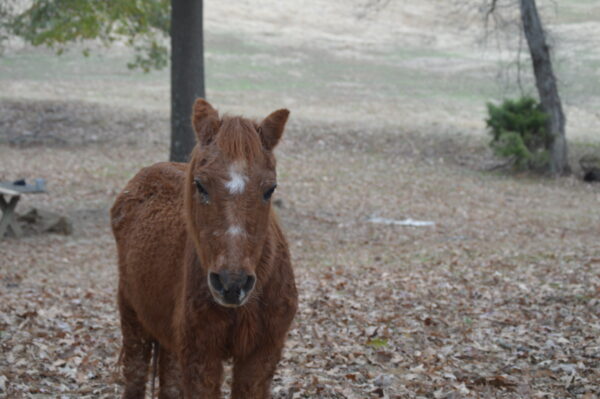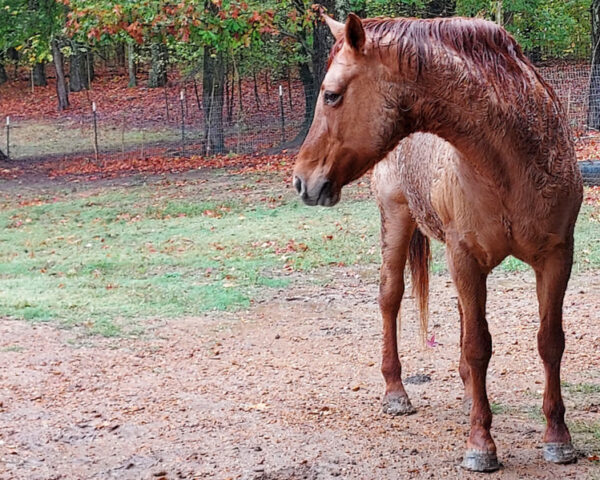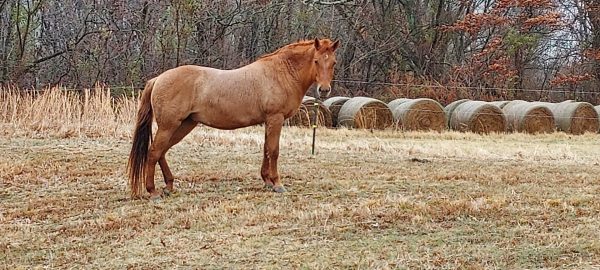 Not every horse becomes an indiscriminate part of its herd, aimlessly following along with the others just because they move about here or there. Even if there’s a pair of them that bond and sidle along side-by-side off to themselves, it’s quite rare for one of the herd to venture off alone, regularly, in search of his or her own pursuits, escaping the strength and protection of the clan.
Not every horse becomes an indiscriminate part of its herd, aimlessly following along with the others just because they move about here or there. Even if there’s a pair of them that bond and sidle along side-by-side off to themselves, it’s quite rare for one of the herd to venture off alone, regularly, in search of his or her own pursuits, escaping the strength and protection of the clan.
Like most people, horses tend to stick together, finding solace in their community. While each member has a roll to fill in the collective, they befriend each other in unique ways, and bop along with their favorite counterpart most of the time. Sometimes they change pairings, but rarely do they splinter. Most always, horses are a collective caste.
They have a leader (here it’s Twix), and a descending order of clout down from the top. There is a first lieutenant (Snickers), who is clearly second in charge but never ahead of the leader. A second lieutenant is several rungs down the leadership ladder from the top horse and the first lieutenant, but still has clout within the group. This horse (Angel) is among the last within the organized power structure, eating after the first two have secured their meals and usually is above the fray of chaos the remainder of the herd create as they romp and stab for order and power (and food).
From here, the remaining subverts of the herd usually fend for themselves. They never bother the herd leader, who always eats first and as much as she can inhale. The first and second lieutenant may have to raise their teeth or turn their rears to another horse that may come too close, but the others fray and bray, circle, and swarm the remaining bowls until they are pushed away by another horse that’s higher on the totem.
Sometimes (usually), there’s a horse too timid to stand or defend itself from the others. While this horse (here it’s Molly) may not be a pushover in the pasture, at feeding time, it can be better to separate this animal from the others to ensure it gets something to eat.
Other times, less often, there’s a horse that doesn’t belong within the structure of the horse economy. A lone flower in the meadow of petals. Beautiful on its own, but apart in its beauty, though not diminished by it’s lack of companionship. For this animal, something is different inside, something that tells it it’s okay to walk on alone.
As with people, there is a silent beauty and confidence in this individual’s ability to go it alone. Observers may see this animal as weak or as something to avoid, but for the loner, their journey requires a quiet strength that powers its ability to find peace and purpose, and perhaps even connect with God at a deep pursuant level. Most accurately, these loners are strong, independent, adventurous, reliable, and fully intent on pursuing some deeper meaning not found in the presence of others or in the inane conversations of an inane world.
Upon closer inspection, these independent souls are leaders in their own wonderful way – poised in their own purposes, and on a mission apart from the rest of the herd mind. Their independence the sign of a castoff to observes from the crow, which wonders “what is wrong” with that one, ridiculed in other’s misunderstanding of them. But their purpose is greater as an individual than as part of a herd, or part of a collection of other minds.
The independent interloper here (was Tibbs) rarely cared for the crowd. Though elderly and physically weak, he sought his own pastures, no matter the time of day, light or dark. When the herd left, he stayed. When the other horses went east, he went south to a favorite green patch. At feeding time, he cared not for the circus created by the others. His independence brought him into a protective relationship with his human caretakers. When the other horses descended on the feeding grounds, he came too, but he slipped straight to the front, out of the way, and the waiting open gate where he became securely tucked away in a safe and warm space with as much grain as he could handle – without the cajoling and caring-on of the others in their endless pursuit for power and position.
Not Tibbs. Most times, he stood apart from the herd though he was always a part of it. His independence allowed him to see through the noise and chaos created by the crowd that so many of us get caught in while we forget our passions and God-called pursuits. While the rest of the herd fight and kick for a portion of their daily, this lone little one procured more because of his willingness to strike out and stand on his own than the others could ever achieve through all their fights.
Tibbs always had other plans. Strong, independent plans. Plans that set him apart, even as he remained a part.
Rest in peace, friend. You’re greatly missed, and forever loved!
 Twix was the ranch’s first resident, coming to live here just before Christmas 2020. Purchased from a local auction, she was likely headed south as part of a meat convoy, where she would have been butchered and shipped overseas for human consumption. But God had other plans for her.
Twix was the ranch’s first resident, coming to live here just before Christmas 2020. Purchased from a local auction, she was likely headed south as part of a meat convoy, where she would have been butchered and shipped overseas for human consumption. But God had other plans for her. 
 Not every horse becomes an indiscriminate part of its herd, aimlessly following along with the others just because they move about here or there. Even if there’s a pair of them that bond and sidle along side-by-side off to themselves, it’s quite rare for one of the herd to venture off alone, regularly, in search of his or her own pursuits, escaping the strength and protection of the clan.
Not every horse becomes an indiscriminate part of its herd, aimlessly following along with the others just because they move about here or there. Even if there’s a pair of them that bond and sidle along side-by-side off to themselves, it’s quite rare for one of the herd to venture off alone, regularly, in search of his or her own pursuits, escaping the strength and protection of the clan. Saturday, Dec. 19, 2020, six days before Christmas. The Christmas animal auction, a west Tennessee annual tradition in Gleason. Tack, tchotchkes, goats and their kids, ducks and geese, ponies, and horses (lame, sound, in various stages of injury).
Saturday, Dec. 19, 2020, six days before Christmas. The Christmas animal auction, a west Tennessee annual tradition in Gleason. Tack, tchotchkes, goats and their kids, ducks and geese, ponies, and horses (lame, sound, in various stages of injury). Having spent years of my youth in farmland in rural South Dakota, I know that life in and around livestock is not always pleasant. It’s rarely clean, overly glossed by the city-based publications that tout “fresh from the farm” and “farm fresh” trademarks to their unaware urbanites who don’t often wonder about the origin of their pork chops and cheeseburgers. The truth is far dirtier and usually much darker than most people would prefer or dare to contemplate.
Having spent years of my youth in farmland in rural South Dakota, I know that life in and around livestock is not always pleasant. It’s rarely clean, overly glossed by the city-based publications that tout “fresh from the farm” and “farm fresh” trademarks to their unaware urbanites who don’t often wonder about the origin of their pork chops and cheeseburgers. The truth is far dirtier and usually much darker than most people would prefer or dare to contemplate.